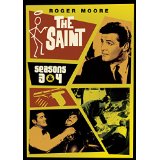“So that’s what it’s like to be Simonized.”
Years before he became the iconic suave British secret agent with the license to kill, Roger Moore might just have put himself in the running through his six-year run on British television’s The Saint. The show was part of the British Invasion of spy shows that came close on the heels of the first James Bond film Dr. No. Moore played Simon Templar, known throughout the globe as The Saint. While Templar wasn’t really a spy, he acted like one most of the time, and the series managed to cover most of the conventions of the genre. There was always a pretty girl or two for Templar to either romance or rescue…often both. Like Bond, Templar was a globetrotter. Episodes took place all over the world. One episode might be in New York City, another in London, while the next two weeks took us from Rome to Paris by way of Monte Carlo.
But Simon Templar wasn’t a spy. He was a world-renowned thief who had decided to give up his life of crime and use his wealth to help those in need. He found his “clients” a variety of ways. Many were friends who called him for help. Others he saw in the news had been taken by a con or were the victims of a frame or other unfortunate circumstance. Templar never charged for the services. He rather saw himself as a white knight and thus earned the reputation of The Saint. Still, the police officers he encountered were never completely convinced he had changed his stripes, and he was usually a prime suspect, or at least followed, whenever he encountered the police. He didn’t mind; in fact, he saw it as a bit of a cat-and-mouse game and often encouraged these treatments.
Each episode would begin with Templar looking straight into the camera and delivering a monologue about his surroundings. He might talk about the people or the place he happened to be. Often the monologue was really some wisecrack remark or odd philosophy statement. The monologue would inevitably be interrupted by someone who would mention him by name. Cut to Templar delivering a boyish grin and a halo appearing over his head. The halo would fade into the show’s trademark of a stick figure with said halo and the opening credits.
The future Bond images continue in this set. A scene has Templar hanging from a moving train fighting with a bad guy. Of course, he’d end up repeating this kind of fight with one of his more iconic Bond villains Richard Kiel as the steel-toothed Jaws. There are conversations about martinis being shaken or stirred. There’s a voodoo episode that reminds us of Live And Let Die. It appears almost as if Moore was auditioning for that future 007 role. He strikes that Bond pose often and wears that impish grin he would nearly trademark as James Bond. There are more than a few car chases in exotic locations. But Roger Moore ends up putting in a much better performance as Simon Templar than he would ever deliver as Ian Fleming’s alter-ego. Here he’s at his best not when he displays the suave and debonair portrait. I’m more fascinated by the fistfights where you get close-ups of the mussed hair and the determined snarl.
There are a couple of Audio Commentaries. There are a total of 32 episodes on nine discs. Season 4 had only nine episodes that aired mostly in the summer of 1965, just two months after the second season “officially” ended. It would be easy to consider this one long season. The fifth would begin to air more than a year later. So far these double-season releases have worked because they’ve both included one short season. The fifth and final sixth season both have 20 or more episodes. It will be interesting to see if they are released separately.
Of course, the character was already an old and established one long before 1962. It started in a series of novels by Leslie Charteris in 1928. The character has been in radio broadcasts and early film serials. Something about Simon Templar continues to entertain audiences for almost 100 years. “It’s really rather witty”.



